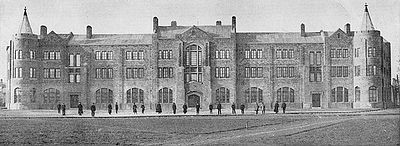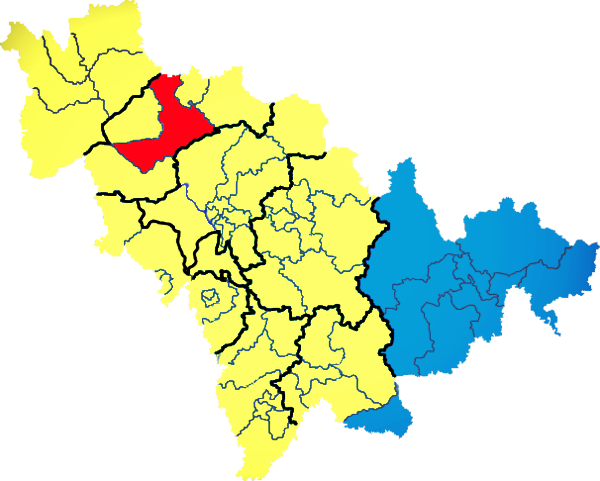|
Zhang Yanqing (politician, Born 1898)
Zhang Yanqing (; Hepburn: ''Chō Enkei''; 1898–1969) was a politician in the early Republic of China who subsequently collaborated with the Japanese imperialists and became the Foreign Minister of Manchukuo, Japan's puppet state. His father Zhang Zhidong was an important official in the later days of the Qing Empire, while his brother Zhang Renli was an official in the Reorganized National Government of China, another Japan's puppet state, making the two brothers as Japanese collaborators. Biography Zhang studied foreign languages at Qingdao and went to Japan to study at the Gakushuin Peer's School in 1920. After his return to China in 1922, Zhang was appointed mayor of Wafangdian in Liaoning Province, and in 1924 was promoted to governor of Zhengding County in Hebei Province, and in 1925 was again promoted to governor of Tianjin under the Beiyang Government. In 1926, Tianjin was elevated to the status of a special province, and Zhang added the post of Chief of Police of H ... [...More Info...] [...Related Items...] OR: [Wikipedia] [Google] [Baidu] |
Manchukuo
Manchukuo, officially known as the State of Manchuria prior to 1934 and the Empire of Great Manchuria thereafter, was a puppet state of the Empire of Japan in Northeast China that existed from 1932 until its dissolution in 1945. It was ostensibly founded as a republic, its territory consisting of the lands seized in the Japanese invasion of Manchuria; it was later declared to be a constitutional monarchy in 1934, though very little changed in the actual functioning of government. Manchukuo received limited diplomatic recognition, mostly from states aligned with the Axis powers, with its existence widely seen as illegitimate. The region now known as Manchuria had historically been the homeland of the Manchu people, though by the 20th century they had long since become a minority in the region, with Han Chinese constituting by far the largest ethnic group. The Manchu-led Qing dynasty, which had governed China since 17th century, was overthrown with the permanent abolition of the ... [...More Info...] [...Related Items...] OR: [Wikipedia] [Google] [Baidu] |
Republic Of China (1912–1949)
The Republic of China (ROC) began on 1 January 1912 as a sovereign state in mainland China following the 1911 Revolution, which overthrew the Manchu people, Manchu-led Qing dynasty and ended China's imperial China, imperial history. From 1927, the Kuomintang (KMT) Northern expedition, reunified the country and initially ruled it as a one-party state with Nanjing as the national capital. In 1949, Nationalist government, the KMT-led government was defeated in the Chinese Civil War and lost control of the mainland to the Chinese Communist Party (CCP). The CCP Proclamation of the People's Republic of China, established the People's Republic of China (PRC) while the ROC was forced to Retreat of the government of the Republic of China to Taiwan, retreat to Taiwan; the ROC retains control over the Taiwan Area, and political status of Taiwan, its political status remains disputed. The ROC is recorded as a founding member of both the League of Nations and the United Nations, and previous ... [...More Info...] [...Related Items...] OR: [Wikipedia] [Google] [Baidu] |
Xi Qia
Xi Qia or Xi Xia (Hsi Hsia; ; Hepburn: ''Ki Kō''; 1883–1950) was a general in command of the Jilin Provincial Army of the Republic of China, who defected to the Japanese during the Invasion of Manchuria in 1931, and who subsequently served as a cabinet minister in Manchukuo. Biography Xi Qia was an ethnic Manchu ( Plain Blue Banner) of the imperial clan of Aisin Gioro as a direct descendant of Murhaci (穆爾哈齊), a younger half-brother of Nurhaci and second son of Taksi, thus, making him a member of the collateral bloodline of the Aisin Gioro clan. He contributed to making and a supporter of efforts to create a new Manchu-dominated state in Manchuria after the Xinhai Revolution overthrew the Qing dynasty in China. As a youth, he studied in Japan at the Tokyo Shimbu Gakko, a military preparatory school for Chinese students, followed by the Imperial Japanese Army Academy. He rose to the rank of lieutenant general and commanding officer of the Provincial Army of Jili ... [...More Info...] [...Related Items...] OR: [Wikipedia] [Google] [Baidu] |
Changchun
Changchun is the capital and largest city of Jilin, Jilin Province, China, on the Songliao Plain. Changchun is administered as a , comprising seven districts, one county and three county-level cities. At the 2020 census of China, Changchun had a population of 9,066,906; its metro area, comprising five districts and one development area, had a population of 5,019,477. Shuangyang and Jiutai districts are not urbanized yet. It is one of the biggest cities in Northeast China, along with Shenyang, Dalian and Harbin. The name of the city means "long spring" in Chinese language, Chinese. Between 1932 and 1945, Changchun was renamed Xinjing ( zh, c=新京 , p=Xīnjīng, l=new capital) or Hsinking by the Kwantung Army as the capital of the Imperial Japanese puppet state of Manchukuo, occupying modern Northeast China. After the Proclamation of the founding of the People's Republic of China, foundation of the People's Republic of China in 1949, Changchun was established as the provincial ... [...More Info...] [...Related Items...] OR: [Wikipedia] [Google] [Baidu] |
Manchuria
Manchuria is a historical region in northeast Asia encompassing the entirety of present-day northeast China and parts of the modern-day Russian Far East south of the Uda (Khabarovsk Krai), Uda River and the Tukuringra-Dzhagdy Ranges. The exact geographical extent varies depending on the definition: in the narrow sense, the area constituted by three Chinese provinces of Heilongjiang, Jilin, and Liaoning as well as the eastern Inner Mongolian prefectures of China, prefectures of Hulunbuir, Hinggan League, Hinggan, Tongliao, and Chifeng; in a broader sense, historical Manchuria includes those regions plus the Amur river basin, parts of which were ceded to the Russian Empire by the Manchu-led Qing dynasty during the Amur Annexation of 1858–1860. The parts of Manchuria ceded to Russia are collectively known as Outer Manchuria or Russian Manchuria, which include present-day Amur Oblast, Primorsky Krai, the Jewish Autonomous Oblast, the southern part of Khabarovsk Krai, and the easter ... [...More Info...] [...Related Items...] OR: [Wikipedia] [Google] [Baidu] |
Jilin
) , image_skyline = Changbaishan Tianchi from western rim.jpg , image_alt = , image_caption = View of Heaven Lake , image_map = Jilin in China (+all claims hatched).svg , mapsize = 275px , map_alt = Map showing the location of Jilin Province , map_caption = Map showing the location of Jilin Province , coordinates = , subdivision_type = Country , subdivision_name = China , named_for = from ''girin ula'', a Manchu language, Manchu phrase meaning "along the river" , seat_type = Capital , seat = , seat1_type = , seat1 = , parts_type = Divisions , parts_style = para , p1 = 9 Prefectures of China, prefectures , p2 = 60 Counties of China, counties , p3 = 1006 Townships of China, townships , government_type = Provinces of China, Province , governing_body = Jilin Provinci ... [...More Info...] [...Related Items...] OR: [Wikipedia] [Google] [Baidu] |
Beiyang Government
The Beiyang government was the internationally recognized government of the Republic of China (1912–1949), Republic of China between 1912 and 1928, based in Beijing. It was dominated by the generals of the Beiyang Army, giving it its name. Beiyang general Yuan Shikai gave Sun Yat-sen the military support he needed to overthrow the Qing dynasty and establish the Republic of China in 1912, following the 1911 Revolution. Through his control of the army, Yuan was quickly able to dominate the new Republic. Although the government and the state were nominally under civilian control through the Republic's constitution, Yuan and his generals were effectively in charge of it. After Yuan's death in 1916, the army split into various warlord factions competing for power, leading to a period of civil war called the Warlord Era. Nevertheless, the government maintained its legitimacy among the great powers, receiving diplomatic recognition, foreign loans, and access to tax and customs revenu ... [...More Info...] [...Related Items...] OR: [Wikipedia] [Google] [Baidu] |
Zhengding County
Zhengding (), originally Zhending (), is a county in southwestern Hebei Province, North China, located approximately south of Beijing, capital of China. It is under the administration of the prefecture-level city of Shijiazhuang, the capital of the province, and has a population of 594,000. Zhengding has been an important religious center for more than 1,000 years, from at least the times of the Sui dynasty to the Qing dynasty. It is the founding place of several major schools of Chan Buddhism. However, many former religious building complexes have been severely damaged throughout history. A noted temple is the Longxing Monastery, where the historical building ensemble has been preserved almost intact. Furthermore, four famous pagodas, each with its own architectural style, are still standing. History Archeological finds indicate that the area of Zhengding County has been settled since the early Neolithic Period. During the Spring and Autumn period, the capital of the Xianyu ... [...More Info...] [...Related Items...] OR: [Wikipedia] [Google] [Baidu] |
Liaoning Province
) , image_skyline = , image_alt = , image_caption = Clockwise: Mukden Palace in Shenyang, Xinghai Square in Dalian, Dalian coast, Yalu River at Dandong , image_map = Liaoning in China (+all claims hatched).svg , mapsize = 275px , map_alt = Map showing the location of Liaoning Province , map_caption = Map showing the location of Liaoning Province , coordinates = , subdivision_type = Country , subdivision_name = China , named_for = —"Liao River, Liao (River)" —"pacification" "Pacified of the Liao (River)" , seat_type = Capital , seat = Shenyang , seat1_type = , seat1 = , parts_type = Divisions , parts_style = para , p1 = 14 Prefectures of China, prefectures , p2 = 100 Counties of China, counties , p3 = 1511 Townships of China, townships , government_type = Provinces of ... [...More Info...] [...Related Items...] OR: [Wikipedia] [Google] [Baidu] |
Wafangdian
Wafangdian (), formerly Fuhsien (Fuxian) or Fu County (), is one of the two "northern county-level city, county-level cities", the other being Zhuanghe, under the administration of Dalian, located in the south of Liaoning province, China. The city is famous for its ball bearing industry. Wafangdian Bearing Factory is the largest bearing manufacturer in Asia and was initially built by the Japanese during World War II. Its area is and its permanent population is 942,197, compared to 1,024,876 registered with hukou permits. The city borders the prefecture-level city of Yingkou to the northeast. Overview Wafangdian City is located in the southwest of the Liaodong Peninsula, with a total area of and a population of around 1.02 million. There are rich mines here. Wafangdian is a newly developed city of diamond in the East and its deposits of diamond account for 54% of the national proven diamond deposits. The deposits of the limestone reach over 400,000,000 cubic metres. Wafangdia ... [...More Info...] [...Related Items...] OR: [Wikipedia] [Google] [Baidu] |





